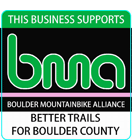From Double Century Road Events To 100 Mile Mountain Bike Races
/printed in UltraMarathon Cycling Association
I’m sure some of you want to pass right over this article and assume that if it’s a mountain bike race or event, then you, as a roadie, are not going to get involved. Let me tell you, if you have ever ridden a double century on your road bike, you are the prime candidate for this article and for several of the mountain bike centuries that are available around the United States.
“Once a roadie, always a roadie”. I have never given up my love for my road bike and continue to put in thousands of road miles every year in order to prepare myself for the handful of 100 mile mountain bike races and 24 hour dirt races I do every summer. It can be the perfect marriage of road riding/training and long distance dirt racing.
In this article I will explain to you why I think you can make go from double century road riding to 100 mile off road events and races and find a new and challenging way to ride your bike all day.
WHY WOULD I LEAVE SMOOTH AND CLEAN FOR ROUGH AND DIRTY?
There is something fantastic and free-feeling about heading into the woods to ride as long and far as you can without ever seeing a single car. Riding off road does not mean riding on rocks, tree roots and mud all day long but exploring new adventures riding through trees and flowers and seeing various animals not often see by the roads. Riding your mountain bike does not mean you have to ride technical.
What few road riders know is that there are a handful of 100 mile mountain bike races that are on courses that are not extremely technical. Think about it. It would be very difficult to put 500 mountain bike racers on 100 miles of single track. Logistically it would be hard to find 100 miles of continuous single track in many areas and it would be equally difficult to keep the 500 or so racers happy and able to pass each other throughout the 8-13 hour day of riding and racing. Many 100 mile race promoters understand that not everyone enters a 100 mile mountain bike race to be one of the top 5 finishers. They want to promote events that have a course that many weekend warriors can accomplish.
This does not mean that you will be able to jump on a mountain bike without ever having ridden one on the dirt, but it does mean that with a little bit of dirt riding you can enter and compete in a century on a mountain bike.
FITTING YOUR MOUNTAIN BIKE:
There is more than I can go into in this article about the best possible fit to a mountain bike but I feel the next few points are the most important.
You want to try to come close to fitting your riding position on your mountain bike to that of your position on your road bike. You will not be able to get the exact fit because mountain bikes have different geometry to road bikes but you can get it close. This will minimize any stress or strains to muscles, joints and tendons. You want to particularly pay close attention to the saddle position in relationship to the bottom bracket, saddle height, and the fore/aft position of your saddle to your handlebars. The nice thing about mountain bikes and road bike these days are that you can use your same shoes and pedals for both.
To check your fore/aft position you can have a friend help you set up your position relative to the pedals. Sit on the saddle of your road bike and clip into your pedals with the crankarms horizontal. Drop a plumb line ( a string with something small but heavy on one end) from the front of your forward leg’s kneecap. Make a mark on the top of your shoe where the plumb drops over your shoe. Do the same sitting on your mountain bike. Get the two positions to match up as closely as you can. You will need to get an appropriate length stem to give you the proper distance to your handle bars in order to be able to have the room to stand, turn, and clear your knees comfortably. Try these few fit techniques and if you find you have some knee aches or other nagging pains that you cannot figure out on your own, ask your coach or make an appointment with a local bike shop fit expert.
HOW SHOULD I ADJUST MY TRAINING?
You know you already love to be on your bike all day now you will be able to do this with different scenery, no cars, and nature at your every glance. You have already developed many of the skills of a 10-12 hour day on your bike, especially those road riders that have tackled a double century or 12 hour endurance event. Many of the skills of doing a double century or riding your bike for 10-12 hours a day easily translate into a non technical 100 mile mountain bike race. Road riding gives you the cardiovascular benefit without getting the rest of your body too beat up. If a mountain bike rider limits their training to only dirt riding, it requires more recovery time. This is why all of your road training actually helps you transfer your fitness to the dirt.
Once you start to ride your mountain bike more you may notice a little more upper body fatigue especially to your hands, arms, upper back and shoulders. These muscles are not used as much when you ride a lot on your road bike. Dirt riding is a whole-body experience. If you do not plan on spending the majority of training on the mountain bike to get the muscles accustomed to the new demands, you will want to get into a gym or weight room to work on basic exercises for each of the upper body groups.
The power and strength you get from training on your mountain bike will benefit your transfer back to your road bike. Riding your mountain bike will give you the skills to handle rough pavement, slippery wet roads, unexpected excursions off the pavement when a gust of wind catches you off guard, and those nasty cobblestones when you head off for PBP.
WHAT DO I EAT ON A 100 MILE MOUNTAIN BIKE EVENT?
Your eating habits for your double road centuries will transfer over to the mountain bike world. You still need to eat a balance of carbohydrates, protein, and fat on your off the bike meals and I would not recommend trying too many different things when it comes to eating during an ultra endurance ride. My eating habits are the same on the mountain bike as they are on my road bike. The biggest difference on the mountain bike is how I get my hydration.
Mountain biking can be bumpy, more dusty and possibly muddy. Because of this I prefer to use a hydration pack on my back with my electrolyte drink of Accelerade in the fluid reservoir. I use a pack system by Deuter, which allows me to carry 70-100 ounces of fluid on my back. I never have to take my hands off of my handlebars for very long and I do not have to worry about getting a bottle back into the bottle cage if the terrain is bumpy.
During the mountain bike century, try to eat at the time stations but limit your time off of your bike. I tend to grab food at the stations and eat as much as possible on the flatter less bumpy sections. There are enough of these sections to allow for proper glycogen replacement during your ride.
MOUNTAIN BIKE RECOVERY:
If you begin to ride your mountain bike more and more, you will need to add a little more recovery in your training plan. Mountain bike riding is more strenuous to the total body and the rougher the trail the more you need recovery. Dirt riding causes a little more pounding and bike handling from the upper body muscles. After a training day on your mountain bike the next day’s ride should be an active recovery day on your road bike and in lower heart rate zones to allow for better total body recovery.




